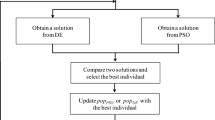Abstract
The self-potential method is widely used in environmental and engineering geophysics. Four intelligent optimization algorithms are adopted to design the inversion to interpret self-potential data more accurately and efficiently: simulated annealing, genetic, particle swarm optimization, and ant colony optimization. Using both noise-free and noise-added synthetic data, it is demonstrated that all four intelligent algorithms can perform self-potential data inversion effectively. During the numerical experiments, the model distribution in search space, the relative errors of model parameters, and the elapsed time are recorded to evaluate the performance of the inversion. The results indicate that all the intelligent algorithms have good precision and tolerance to noise. Particle swarm optimization has the fastest convergence during iteration because of its good balanced searching capability between global and local minimisation.
Similar content being viewed by others
References
de CARLO L, PERRI M T, CAPUTO M C, DEIANA R, VURRO M, CASSIANI G. Characterization of a dismissed landfill via electrical resistivity tomography and mise-à-la-masse method [J]. Journal of Applied Geophysics, 2013, 98(11): 1–10.
JARDANI A, REVILl A, SANTOS F A M. Detection of preferential infiltration pathways in sinkholes using joint inversion of self-potential and EM-34 conductivity data [J]. Geophysical Prospecting, 2007, 55(5): 749–760.
ABDELRAHMAN E M, ESSA K S, ABO-EZZ E R. New least-square algorithm for model parameters estimation using selfpotential anomalies [J]. Computers & Geosciences, 2008, 34(11): 1569–1576.
ABDELRAHMAN E M, EL-ARABY H M, EL-ARABY T M. New methods for shape and depth determinations from SP data [J]. Geophysics, 2003, 68(4): 1202–1210.
FERNANDEZ-MARTINEZ J L, GARCIA-GONZALO E, FERNANDEZ-ALVAREZ J P, KUZMA H A, MENENDEZ-PEREZ C O. PSO: A powerful algorithm to solve geophysical inverse problems application to a 1D-DC resistivity case [J]. Journal of Applied Geophysics, 2010, 71(1): 13–25.
WANG R, YIN C, WANG M, WANG G. Simulated annealing for controlled-source audio-frequency magnetotelluric data inversion [J]. Geophysics, 2012, 77(2): E127–E133.
SHARMA S P, BISWAS A. Interpretation of self-potential anomaly over a 2D inclined structure using very fast simulated-annealing global optimization-An insight about ambiguity [J]. Geophysics, 2013, 78(3): WB3–WB15.
BISWAS A, SHARMA S P. Optimization of self-potential interpretation of 2-D inclined sheet-type structures based on very fast simulated annealing and analysis of ambiguity [J]. Journal of Applied Geophysics, 2014, 105(2): 235–247.
BALKAYA C. An implementation of differential evolution algorithm for inversion of geoelectrical data [J]. Journal of Applied Geophysics, 2013, 98(3): 160–175.
SONG X, LI L, ZHANG X, HUANG J, SHI X, JIN S, BAI Y. Differential evolution algorithm for nonlinear inversion of high-frequency Rayleigh wave dispersion curves [J]. Journal of Applied Geophysics, 2014, 109(10): 47–61.
BIJANI R, PONTE-NETO C F, CARLOS D U, SILVA-DIAS F J S. Three-dimensional gravity inversion using graph theory to delineate the skeleton of homogeneous sources [J]. Geophysics, 2015, 80(2): G53–G66.
GRUTAS R, YAMANAKA H. Shallow shear-wave velocity profiles and site response characteristics from microtremor array measurements in Metro Manila, the Philippines [J]. Exploration Geophysics, 2012, 43(4): 255–266.
FERNANDEZ-MARTINEZ J L, GARCIA-GONZALO E, NAUDET V. Particle swarm optimization applied to solving and appraising the streaming-potential inverse problem [J]. Geophysics, 2010, 75(4): WA3–WA15.
FERNANDEZ-MARTINEZ J L, MUKERJI T, GARCIAGONZALO E, SUMAN A. Reservoir characterization and inversion uncertainty via a family of particle swarm optimizers [J]. Geophysics, 2012, 77(1): M1–M16.
ZHU Xiao-xiong, CUI Yi-an, LI Xi-yang, TONG Tie-gang, JI Tong-xin. Inversion of self-potential anomalies based on particle swarm optimization [J]. Journal of Central South University: Science and Technology, 2015, 46(2): 579–585. (in Chinese)
PEKSEN E, YAS T, KAYMAN A Y, OZKAN C. Application of particle swarm optimization on self-potential data [J]. Journal of Applied Geophysics, 2011, 75(2): 305–318.
SONG X, TANG L, LV X, FANG H, GU H. Application of particle swarm optimization to interpret Rayleigh wave dispersion curves [J]. Journal of Applied Geophysics, 2012, 84(9): 1–13.
PALLERO J L G, FERNANDEZ-MARTINEZ J L, BONVALOT S, FUDYM O. Gravity inversion and uncertainty assessment of basement relief via particle swarm optimization [J]. Journal of Applied Geophysics, 2015, 116(3): 180–191.
YAN Z, GU H, CAI C. Automatic fault tracking based on ant colony algorithms [J]. Computers and Geosciences, 2013, 51(02): 269–281.
LIU S, HU X, LIU T, XI Y, CAI J, ZHANG H. Ant colony optimization inversion of surface and borehole-magnetic data under lithological constraints [J]. Journal of Applied Geophysics, 2015, 112(1): 115–128.
EL-KALIOUBY H M, AL-GAMI M A. Inversion of Self-potential anomalies caused by 2D inclined sheets using neural networks [J]. Journal of Geophysics and Engineering, 2009, 6(1): 29–34.
Author information
Authors and Affiliations
Corresponding author
Additional information
Foundation item: Project(41574123) supported by the National Natural Science Foundation of China; Project(2015zzts250) supported by the Fundamental Research Funds for the Central Universities, China; Project(2013FY110800) supported by the National Basic Research Scientific Program of China
Rights and permissions
About this article
Cite this article
Cui, Ya., Zhu, Xx., Chen, Zx. et al. Performance evaluation for intelligent optimization algorithms in self-potential data inversion. J. Cent. South Univ. 23, 2659–2668 (2016). https://doi.org/10.1007/s11771-016-3327-2
Received:
Accepted:
Published:
Issue Date:
DOI: https://doi.org/10.1007/s11771-016-3327-2




